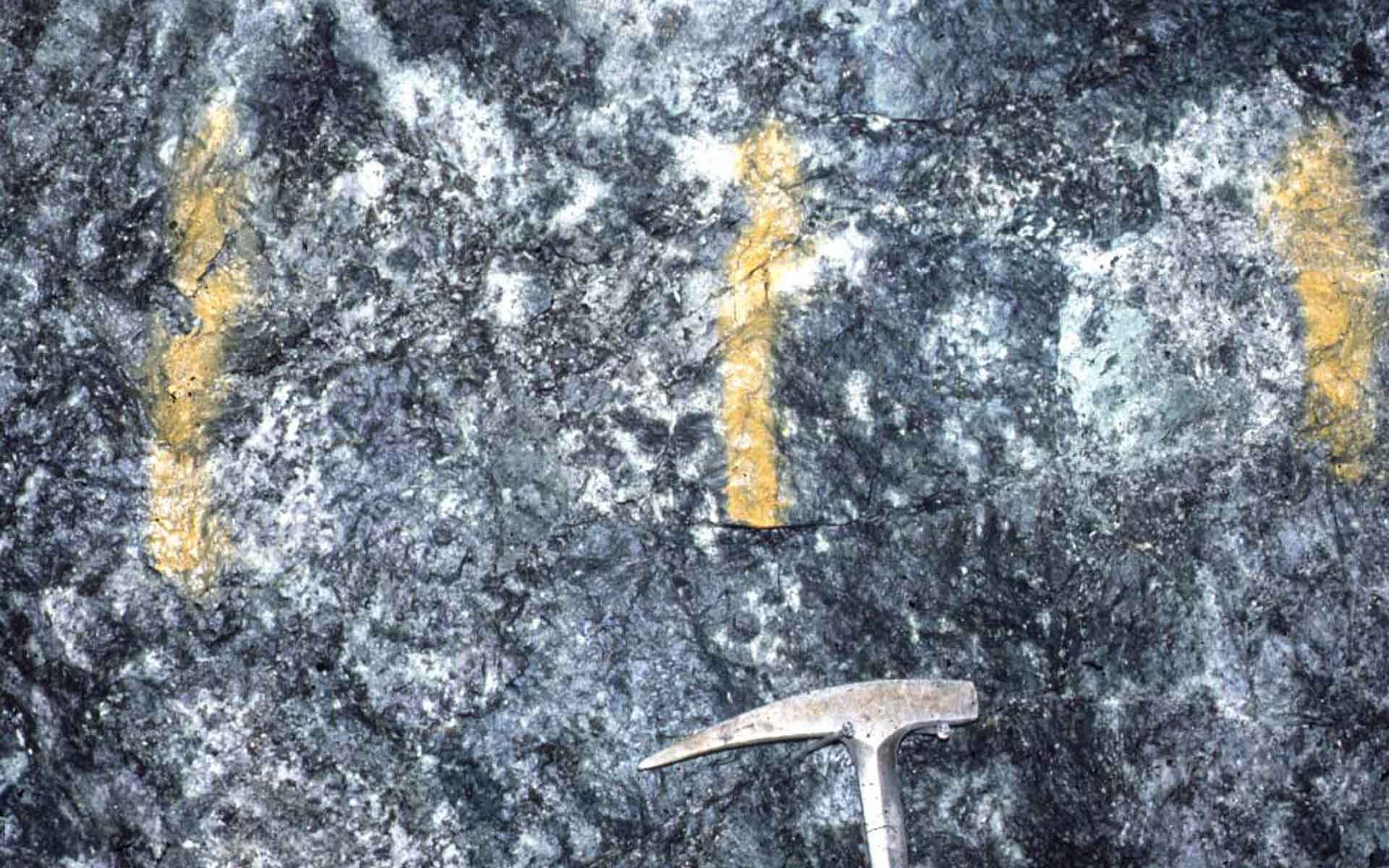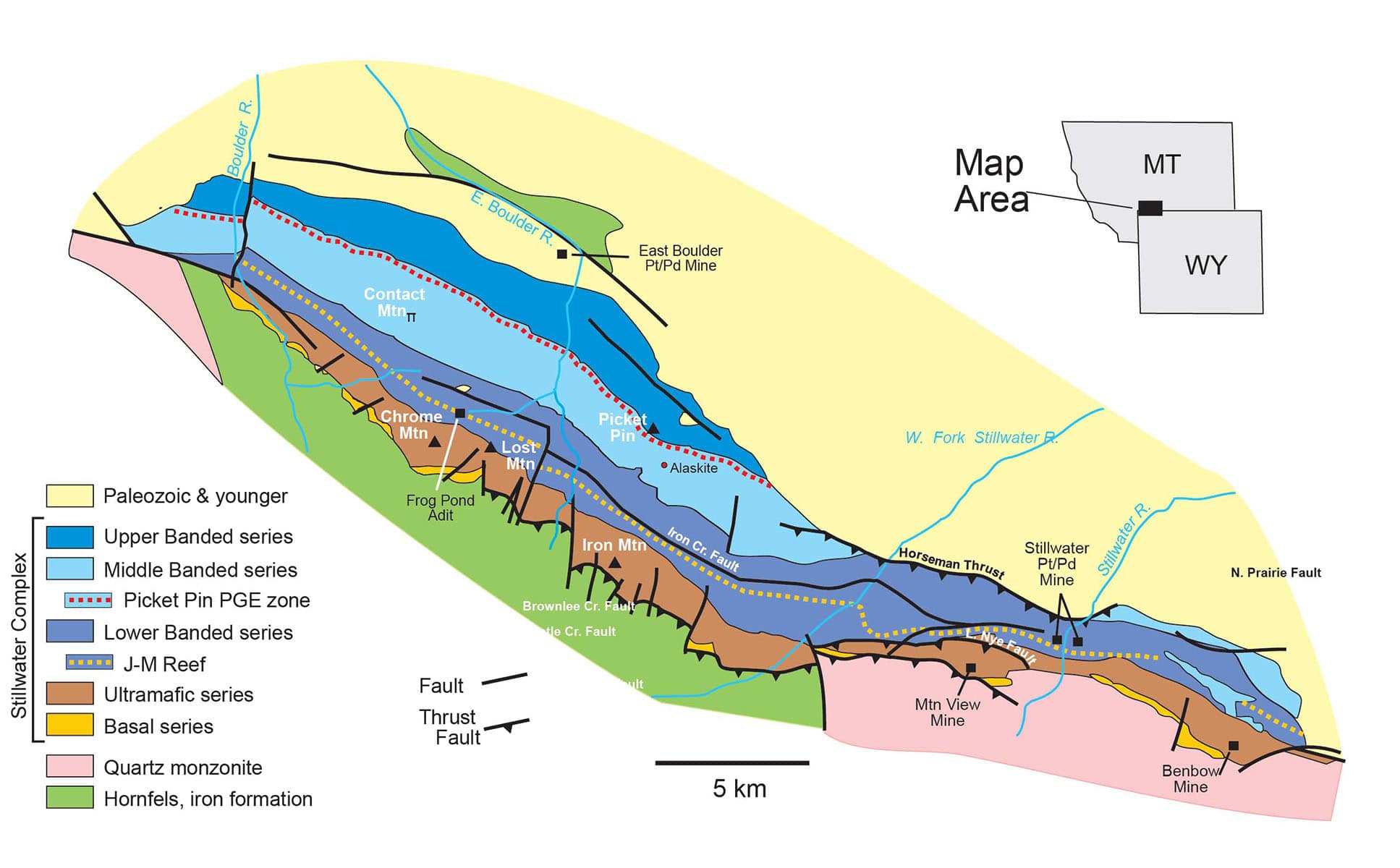
Outcrop of “inch-scale doublets” tilted to vertical; original stratigraphic “up” is to the right. (Photo courtesy Brian O’Driscoll).
Geological Period
Neoarchean
Main geological interest
Igneous and Metamorphic petrology.
Location
Montana, USA centered at approximately.
45°25’00.0″N, 110°00’00.0″W
Outcrop of “inch-scale doublets” tilted to vertical; original stratigraphic “up” is to the right. (Photo courtesy Brian O’Driscoll).
One of the world’s oldest layered intrusions, containing the world’s highestgrade platinum-group element deposit
The Stillwater Complex has been an important laboratory for understanding a host of igneous processes and magmatic ore deposit models. These include the use of the thick Stillwater anorthosites as analogues for understanding the origin of lunar anorthosites (Salpas et al., 1983). More recently, investigations have centered on role of high-temperature hydrothermal processes vs. conventional magmatic precipitation mechanisms for the concentration of Cr and platinum-group element deposits in layered intrusions (Boudreau et al., 2020). This includes debate if the reappearance of olivine in the stratigraphy is the result of conventional magmatic mixing schemes or is instead the result of incongruent melting owing to volatile fluxing.
- Geological description
The 2.7 Ga age Stillwater Complex is a large layered intrusion, with a ~5.5 km thick section exposed for ~50 km along the northern front of the Beartooth Mountains in south-central Montana. Starting from its lower contact, it is divided into the Basal series (composed of norite and orthopyroxenite), the Ultra¬mafic series (composed of dunite, harzburgite, and orthopyroxenite), and the Banded series (composed of norite, gabbronorite, troctolite, and anorthosite). The upper part was eroded and covered in the late Pre-cambrian-early Proterozoic.
The outcrop of “inch-scale doublets” (Photo, previous page) is unique to the complex, and photos of it are found in many petrology textbooks as an example of pattern formation during magmatic crystallization (Boudreau, añadir coma 1995). Ni- and Cu-rich sulfide occur in the lower part of the complex and into the underlying hornfels. Chromite-rich seams associated with peridotite of the Ultramafic series were mined under government contract sporadically between 1940’s the early 1960’s (Jackson, 1961). In the 1970’s the J-M Reef in the Lower Banded series was discovered. It is a world-class platinum-group element deposit that is the highest-grade deposit of its type and is the only significant source for these elements in the United States (Zientek et al., 2002).
- Scientific research and tradition
Zientek and Park (2014) note that there are over 600 Stillwater–related publications dating back to the late 1800’s, with many from researchers based around the world. In addition, it has been the focus of numerous scientific conferences and published field trip guides.
- Reference
Boudreau, A.E. (1995) ‘Crystal aging and the formation of fine-scale igneous layering’, Mineralogy and Petrology, 54(1), pp. 55–69. Available at: https://doi.org/10.1007/BF01162758.
Boudreau, A.E. et al. (2020) ‘Mineral deposits of the Stillwater Complex’, in Montana Bureau of Mines and Geology Special Publication. (Geology of Montana, 122).
Jackson, E.D. (1961) Primary textures and mineral associations in the ultramafic zone of the Stillwater complex, Montana, Professional Paper. 358. U. S. Govt. Print. Off., p. 106. Available at: https://doi.org/10.3133/pp358.
Meurer, W.P. and Boudreau, A.E. (1996) ‘Petrology and Mineral Compositions of the Middle Banded Series of the Stillwater Complex, Montana’, Journal of Petrology, 37(3), pp. 583–607. Available at: https://doi.org/10.1093/petrology/37.3.583.
Salpas, P.A., Haskin, L.A. and McCallum, I.S. (1983) ‘Stillwater Anorthosites: A lunar analog?’, Journal of Geophysical Research: Solid Earth, 88(S01), pp. B27–B39. Available at: https://doi.org/10.1029/JB088iS01p00B27.
Zientek, M.L. et al. (2002) ‘Platinum-group element mineralization in the Stillwater Complex, Montana’, in The geology, geochemistry, mineralogy and mineral beneficiation of platinum-group elements. Cabri, L.J., ed. (Canadian Institute of Mining and Metallurgy Special Volume, 54), pp. 459–481. Available at: https://pubs.er.usgs.gov/publication/70221813.
Zientek, M.L. and Parks, H.L. (2014) A geologic and mineral exploration spatial database for the Stillwater Complex, Montana, A geologic and mineral exploration spatial database for the Stillwater Complex, Montana. USGS Numbered Series 2014–5183. Reston, VA: U.S. Geological Survey, p. 40. Available at: https://doi.org/10.3133/sir20145183.
- Author(s)
Alan Boudreau
Duke University, North Carolina, USA


